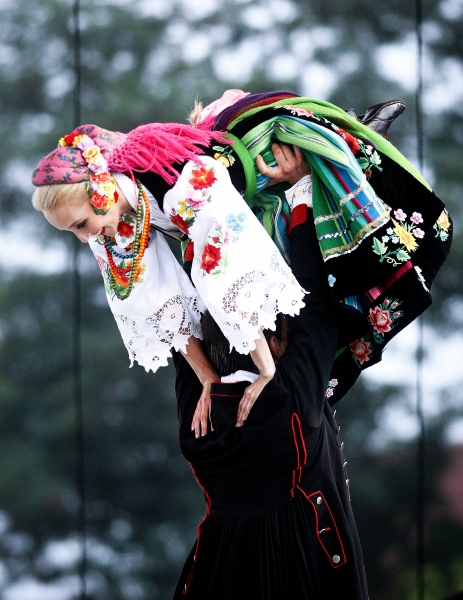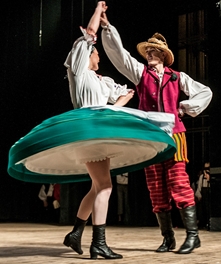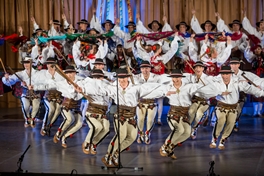Classification and categories used on the website: an attempt at specification and explanation
At the junction of the peasant’s hut, the parlour, and the stage
The framework typology adopted for the purposes of the website has been inspired by the tradition of European theatre dance which dates back at least to the late 18th century. At that time, Jean Georges Noverre’s postulates had elicited a wide-ranging response throughout Europe, accompanied by the growing importance of dramatic scenes in stage practice which apart from pantomime were now using the yet unfixed technique of classical dance. Classical dance, in turn, was emancipating from prototypical baroque, sometimes even Renaissance, court dances, which had simply become outdated. In the course of the 19th century, these dances were perceived as a measure of past references, hence their new label of “historical dances”, which gradually expanded as subsequent dances performed by the upper classes were added to the list along with the passing of consecutive dance trends. Simultaneously, dances popular at the time with those social groups, in particular those beloved by the bourgeoisie, would be denoted as “ballroom (social) dances”, a label simplified in the era of dance halls to that of “social dances”.
Apart from the influence of historical court dances or contemporary social dances, the late 18th century theatrical practice also included a rather voluminous category of characteristic dances. Among these, particularly important to the sentimentalist ballet were the so-called “peasant” dances (exceptionally well developed by the students and followers of Noverre, particularly Dauberval), which were classical reinterpretations of forms referred to as “folk” dances (i.e. dances popular among peasants and plebeians). Some of them were elevated by the theatre and the upper classes, with numerous contributions from ballet masters, dance teachers, theoreticians and court propagandists. The ideologization and reinterpretation of the style of ballroom (social) dances eventually led to their designation as “national dances”. Such ennoblement did occur in the 17th century with reference to “French”, “English” and “Italian” dances. In the 18th century, the group was expanded to include “Spanish”, “Polish”, and “German” dances, and in the 19th century, when the French, the English, and Germans began to treat their music and dances as emanations of universal values, the group of national dances in Europe contained at least a dozen of younger dance styles hailing from different countries. Interestingly, the phenomenon concerned mainly those nations which had been conquered or subjugated (among them Scots, the Irish, Norwegians, Poles, Czechs, Ukrainians, Hungarians, Serbs, and Spaniards), often in combination with national liberation ideologies.
Why is the theatre dance tradition so import ant to us? Above all owing to the fact that contemporary dance studies, i.e. choreology, developed as late as between the second and fourth decades of the 20th century. Prior to that, it was precisely theatre (in line with the bourgeois parlour) that shaped the common dance imagery and the theoretical discourse on dance. Thus, dance studies and choreology became natural heirs to earlier, firmly established terminology, such as:
– classical dance,
– historical dance,
– ballroom (social) dance,
– folk dance,
– national dance,
– and characteristic dance, i.e. a combination of several among the above terminological denotations.
The above division, similarly to any other typology based on practice rather than in-depth theoretical analysis, remains far from precise, and uses designations many find controversial. Such was already the case with the emergence of first categories, since some historical dances were still used in educational practice, and some national dances also conformed to the standards set for their ballroom and historical counterparts. As of now, the terminology is even less unequivocal, because what was considered as examples of ballroom, national, or folk dances in the early 19th century, has acquired a de facto historical status by today. On the other hand, many circles involved in the research, preservation, popularization or even reintroduction of country dances strives to shed the “folk dance” label, instead opting for “regional dance” or “traditional dance”. This likely results from the fact that, contrary to their ancestors, the descendents of 19th century peasants are free and educated people with extensive cultural outlook. Moreover, the adjective may also have negative connotations with the bygone political system which continues to evoke mixed sentiments. The alternative denotation (“traditional dances”) may in turn appear as an appropriation of historical phenomena; should we not extend the use of the above term onto national and historical dances documented for over four centuries? Even if we disambiguate the term and propose a more precise label of “traditional country dances”, it will likely fail to account for the urban tradition, let alone the customary performances of those dances among landed gentry.
In the light of the above, the aforementioned division cannot serve as a basis for an objective, academic typology. Still, since no proposal for the categorization of the wide range of dance phenomena in Poland has been put forward so far, this website opts for the use of the firmly established division of dances, however questionable.
Various manifestations of traditional dance today
The value of traditional dances in Europe was first discovered in the Romantic era, when dynamic social and cultural transformations (such as the enfranchisement and migrations of peasants, development of the educational system in the country, and industrialisation, among others) caused the decline of local peasant and plebeian dances. The development of studies on dances was thus accompanied by the demise of performances of traditional peasant dances. In Poland, the phenomenon was first noticed by Kazimierz Brodziński in 1829, in the area surrounding Warsaw. In the second half of the 19th century, Polish ethnographer Oskar Kolberg repeatedly pointed out that the waning of traditional beliefs and convictions snowballed the disappearance of ritual formulas (including the dance and music repertoire through which they were manifested). Kolberg also noticed that many original features of Polish folklore (including folk dance) were gradually superseded by models adopted from mansions and cities due to cultural aspirations of peasants. In the subsequent period, these changes proceeded at an even quicker pace, e.g. the interwar period saw the introduction of dance hall forms to the country repertoire (tango, foxtrot), while the post-war period included the infusion of genres popularised by mass media (boogie-woogie, rock and roll, twist).
The decline of tradition was very uneven – musical and dance traditions in their primeval function of live folklore[1] were preserved in the areas which lagged behind in terms of economy or had a strong sense of local or regional autonomy (frequently in combination with its appreciation at the hands of the upper classes). Such regions included Podkarpacie, Karpaty and Pogórze, Podlasie, Leszczyńskie, Lubelskie, Łowickie, Rawskie, Radomskie, Mazowsze Leśne and Kurpie. On the other hand, the aforementioned changes took place much more rapidly in the regions of Ziemia Lubuska, Silesia, Kaszuby, Stare Mazowsze, as well as around the major urban centres (Warsaw, Cracow, Poznań).
Contemporary baptism parties, weddings, name-days and dance parties no longer feature traditional dance genres (beside exceptional cases, most of them conditioned ideologically, as well as local initiatives to preserve or reinvent traditional customs). Many people still live who remember the presence of traditional genres and dance customs, although most of them have not practiced them since the 1950s (the area around Kraków) or, at best, in the 1980s (the area around Radom). We may pity the lack of any systematic film documentation of dances in Poland, which contributed to a very scarce number of recordings which present dance situations in their original context. Nowadays, if we fail to seek out traditional musicians and dancers in their homes, we may only admire the work of those who perform to live audiences and thus adapt to a different, stage form of folk dance presentation, often fitted to the demands of various competitions. Such performances, however, belong to the phenomenon of secondary folklore, also known as folklorism[2]. Thus, numerous traditional culture activists hope for the resuscitation of live folklore within the confines of dance houses, an adaptation of the Hungarian idea to adapt historical dance forms to their contemporary entertainment functions. The leaders of this movement, educated by village dancers do possess a vast knowledge of historical country dances along with a range of attendant customs. And yet, we may ask if these dances can possibly recover the original emotions which accompanied them in rural areas when performed in contemporary urban environment? Will the continued transfer of “folk knowledge” to younger generations in the form of urban dance parties manage to avoid the simplification of historical forms of dance customs, typical of the inexistent rural environment? Dance anthropologists remain somewhat skeptical in this regard…
In the circumstances delineated above, the continuity of tradition is ensured by dance ensembles, whose activity we may describe as “dance folklorism”. Their functioning is strongly set in the Polish theatre tradition, as peasant dances became a welcome component of theatrical productions as early as in the 18th century. Beginning with the 1840s, this process was accompanied by the development of folk theatre which often drew from country dance. Finally, between the late 19th century and the 1930s, many regions with highly developed senses of local identities, such as the Silesian Beskids, Biskupizna, Kurpie, Łowickie, and Podhale, saw the appearance of amateur dance ensembles presenting stage arrangements of dances whose form was close to the original. The word “close” is key here, because the changing context of performance influences the very form of a given dance, in which the performers become “aware of the audience”; we are also unable to ensure the presence of identical emotions in contemporary conditions[3]. When systematizing the issue of Polish folk ensembles, Józef Burszta referred to them as authenticated (or authentic) ensembles. These groups, wrote Burszta, are “comprised mostly of the former carriers of folklore and their descendants”, and as such presented regional folklore, which they experienced or which was directly transmitted to them. Their programmes are characteristically simple, austere, and authentic, both in terms of the repertoire (dances, songs), and situational context (dance customs, rituals). The authenticity of these bands is highlighted by their costumes and the accompaniment of music bands playing local music using regional instruments[4].
Aside from the aforementioned regions, the inhabitants of the remaining areas of the country began to act in the middle of the 1930s or, worse, towards at the end of the first half of the 20th century, when live folklore had already been declining. This largely impeded the continuation of original forms, requiring that their preservation be conducted based on documentation presented by local ensembles in the form of dance choreographies. These ensembles were referred to by Burszta as ensembles with prepared repertoires or “semiprofessional” ensembles, pointing to the role of institutional patronage over such groups, which nowadays also extends to authenticated ensembles. Members of ensembles with prepared repertoires usually represent one age group (mostly youth), who are introduced to selected elements of folklore by a specialist in a given field. They present programmes which feature selected, choreographically attractive themes of their regional folklore (or those of other regions) upon their creative arrangement. These programmes amount to new stage pieces, usually presented in the form of dance suites. The approach to tradition is highlighted by costumes, which are patterned after ceremonial peasant garment, and by musical accompaniment provided by large instrumental bands fashioned after classical models[5].
Parallel to the establishment of ensembles presenting repertoires prepared in accordance with the ballet tradition was the coming of folkloristic presentations loosely inspired by various documentations of traditional forms, yet amounting to new dance phenomena. Such presentations of Polish dance folklore on stage are marked by the presence of classical dance techniques (in the interwar period they also included elements of expressionist dance, now supplanted by contemporary dance), as well as the exaggeration of original features of presented dances, along with the grotesque and acrobatics. The forerunner of this trend in Poland was Feliks Parnell, whose successful Polish Ballet found many followers. The trend continued to flourish in the post-war period, led by such choreographers Jadwiga Hryniewiecka and Elwira Kamińska, and was perfected by professional ensembles and likewise practiced by amateur groups; the above style of presentation is commonly referred to as stylisation. Ethnologist Józef Burszta postulated the inclusion of unchanged, authentic elements in stylisations[6], although he bemoaned the instrumental treatment of village traditions by professional ensembles, who treated them as a mere “starting point for unrestrained performances”, where “elements of folklore tend to provide material for completely new stage works”[7]. All attempts at ideological restriction of stylisations are doomed to fail when clashing with creative liberties taken by the artist. Thus, the phenomenon of stylisation escapes unequivocal categorizations.
Due to the that Poland’s “contemporary, disintegrated society has lost direct contact with dance, which ceased to be an inseparable part of our communal life” (as observed by Roderyk Lange)[8], stage dances play an extraordinary role in shaping our understanding of what we refer to as traditional dances. The aforementioned three types of organization of stage presentations result in the firm establishment of dance forms through stage practice. Reasoning by analogy, we may therefore differentiate between:
– authentic dances – dance genres which used to constitute live folklore, transmitted to us by authenticated ensembles or documentation collected through research and field studies conducted by ethnographers, ethnochoreologists, ethnomusicologists, dance folklore enthusiasts);
– prepared dances – forms developed in the course of long-lasting educational and stage practice carried out by dance instructors and pedagogues, in which local variants documented through field studies merge into geographically unspecified entities, while secondary features of respective dances are reduced due to the indirect nature of knowledge transmission;
– stylised dances – forms inspired by selected elements of documented (or socially acknowledged) rural traditions, developed through dance techniques and measures which were foreign to regional cultures; the limits of stylisation are shaped to a greater degree by the shortcomings of performance apparatus, stage conventions and choreographic creativity than by the transmission of knowledge by communities tied to traditional cultures.
Yet another, somewhat simplified classification may be proposed according to the different attitudes to original sources, namely a division into stylised and non-stylised dances. In this case, the notion of non-stylised dances refers to both authentic and prepared dances which – contrary to stylised dances – use solely traditional elements, regardless of the fact that – as mentioned above – in the case of prepared dances, it is the region rather than a given village which delimits the authenticity of particular elements, not without reduction to their stage execution.
[1]Józef Burszta, Chłopskie źródła kultury [Peasant Origins of Culture], Warsaw 1985, p. 298.
[2]Józef Burszta, Chłopskie źródła kultury [Peasant Origins of Culture], Warsaw 1985, p. 299.
[3]Roderyk Lange, O istocie tańca i jego przejawach w kulturze. Perspektywa antropologiczna [On the Nature of Dance and its Manifestations in Culture: An Anthropological Perspective], Poznań 2009, pp. 147-148.
[4]Józef Burszta, Chłopskie źródła kultury [Peasant Origins of Culture], Warsaw 1985, p. 311.
[5]Józef Burszta, Chłopskie źródła kultury [Peasant Origins of Culture], Warsaw 1985, pp. 311-312.
[6] Józef Burszta, Folkloryzm w Polsce [Folklorism in Poland], in: Folklor w życiu współczesnym [Folklore in Contemporary life], Bogusław Linette (ed.) Poznań 1970, p. 26.
[7] Józef Burszta, Chłopskie źródła kultury [Peasant Origins of Culture], Warsaw 1985, pp. 311-312.
[8]Roderyk Lange, O istocie tańca i jego przejawach w kulturze. Perspektywa antropologiczna, [On the Nature of Dance and its Manifestations in Culture: An Anthropological Perspective], Poznań 2009, p. 150.












